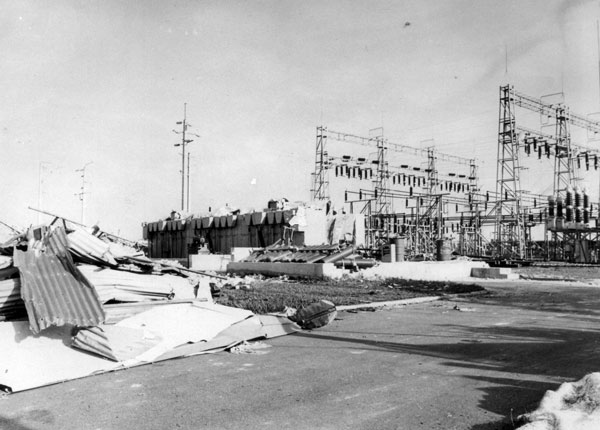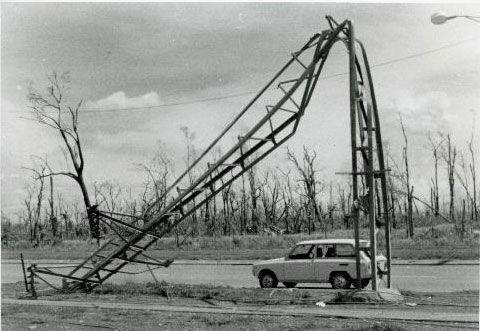In December 1974, Cyclone Tracy devastated Darwin and completely annihilated the city’s electricity supply.
On Christmas Eve most suburbs had lost power by 9pm and Stokes Hill Power station was closed down at 3.30am on Christmas Day. At this stage there was no more water or power supply and 90 per cent of power distribution lines had been destroyed.
Located on the shore, Stokes Hill power station was subjected to extremely high winds and drenched in salt water. Although the power station sustained no significant plant damage, extensive damage to roofing and walls allowed water to flood the station and destroy electrical equipment.
All substations were damaged by airborne debris. Casuarina zone substation collapsed completely, both switchgear and control panels being buried under the rubble. Overhead distribution systems were totally destroyed.
The first power output originated from Stokes Hill power station on 26 December. It was provided by a 350kW diesel set, completed by a larger 1380kW set brought back in service on 29 December. The priority was to restore power to the hospital which was treating the casualties. The main ward’s roof was repaired to protect two emergency diesel generating sets. Overhead distribution lines were hastily repaired using salvage materials and by 29 December, reticulated power returned to the hospital.
Darwin residents waiting for power reconnection were able to apply for a mobile generating set provided by the Army. These sets were sufficient to operate a fan, a fridge and a light but demand exceeded by far the available supply. On 25 January a milestone was reached with power restored to 1200 houses and 200 commercial customers between Darwin and Nightcliff.
Thirty-one interstate authorities participated in the power reconnection. Queensland electricity crews were the first to arrive with a team of fourteen men from the Townsville Regional Electricity Board (TREB) on 27 December. A team of six men from the Blue Mountains City Council followed a day after.
Navy boilermakers, fitters, crane and transport drivers, riggers, electricians, and even Fannie Bay Goal prisoners assisted in the reconnection operations. The Department of Housing and Construction in Canberra, the Sydney County Council and the Electricity Trust of South Australia sent convoys carrying building material, drums of electric cables, switching gear, generators and rations. By the time Darwin was fully restored six months later, approximately 1000 interstate crew members had been seconded to Darwin.
The restoration of electricity supply after the devastation of Cyclone Tracy cost $10 million and 300,000 labour hours.


